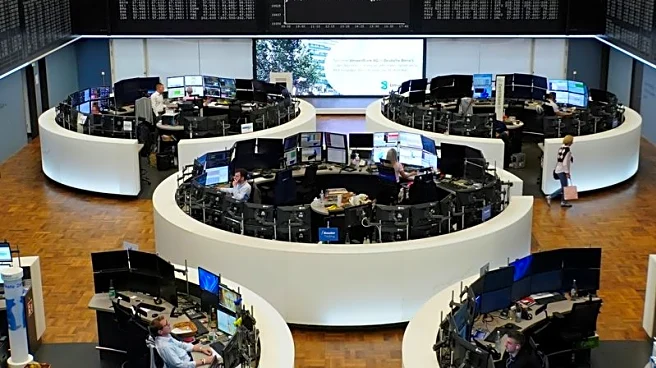What is the story about?
What's Happening?
The U.S. Federal Reserve has implemented a quarter-percentage-point interest rate cut, marking its first dovish policy move since December. This decision has contributed to a significant rally in global stock markets, particularly in the technology sector. European semiconductor stocks, including BE Semiconductor, ASML, and ASMI, experienced substantial gains, mirroring the positive performance of their U.S. counterparts. The pan-European STOXX 600 index rose by 0.79%, driven by a 4.1% increase in the technology sector. The Fed's decision is part of a broader strategy to prevent further weakening in the labor market, with additional rate cuts projected for October and December.
Why It's Important?
The Federal Reserve's interest rate cut is a critical development for the global economy, as it signals a shift towards monetary easing. This move is likely to have significant implications for U.S. industries, particularly those reliant on borrowing and investment. The technology sector, which has been a major driver of economic growth, stands to benefit from lower borrowing costs, potentially leading to increased innovation and expansion. However, the rate cut also reflects concerns about the labor market, indicating potential challenges ahead. Investors are responding positively to the Fed's cautious approach, which suggests stability rather than major economic concerns.
What's Next?
The Federal Reserve has indicated further interest rate cuts in the coming months, with meetings scheduled for October and December. This gradual approach to monetary easing is expected to continue influencing stock market performance, particularly in sectors sensitive to interest rates. Stakeholders, including businesses and investors, will be closely monitoring the Fed's actions and their impact on economic indicators. Additionally, political leaders and policymakers may react to these developments, considering adjustments to fiscal policies to complement the Fed's strategy.
Beyond the Headlines
The Fed's decision to cut interest rates may have deeper implications for economic inequality and financial stability. Lower interest rates can lead to increased asset prices, benefiting those with investments in stocks and real estate, potentially widening the wealth gap. Additionally, prolonged periods of low interest rates can encourage excessive risk-taking, raising concerns about financial bubbles. These factors highlight the need for careful monitoring and potential regulatory measures to ensure balanced economic growth.
AI Generated Content
Do you find this article useful?














